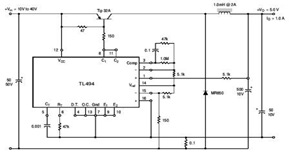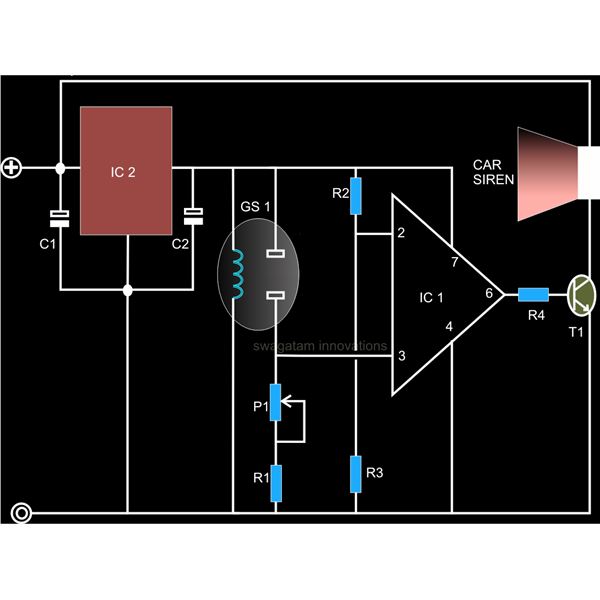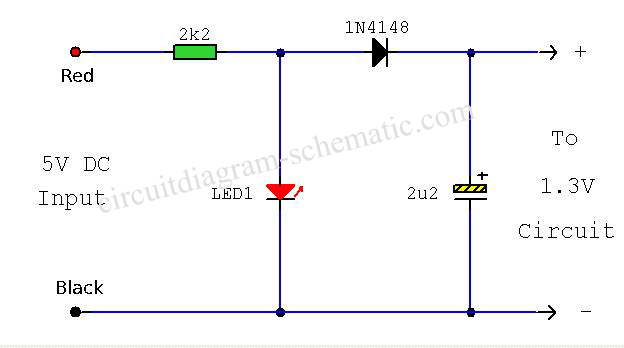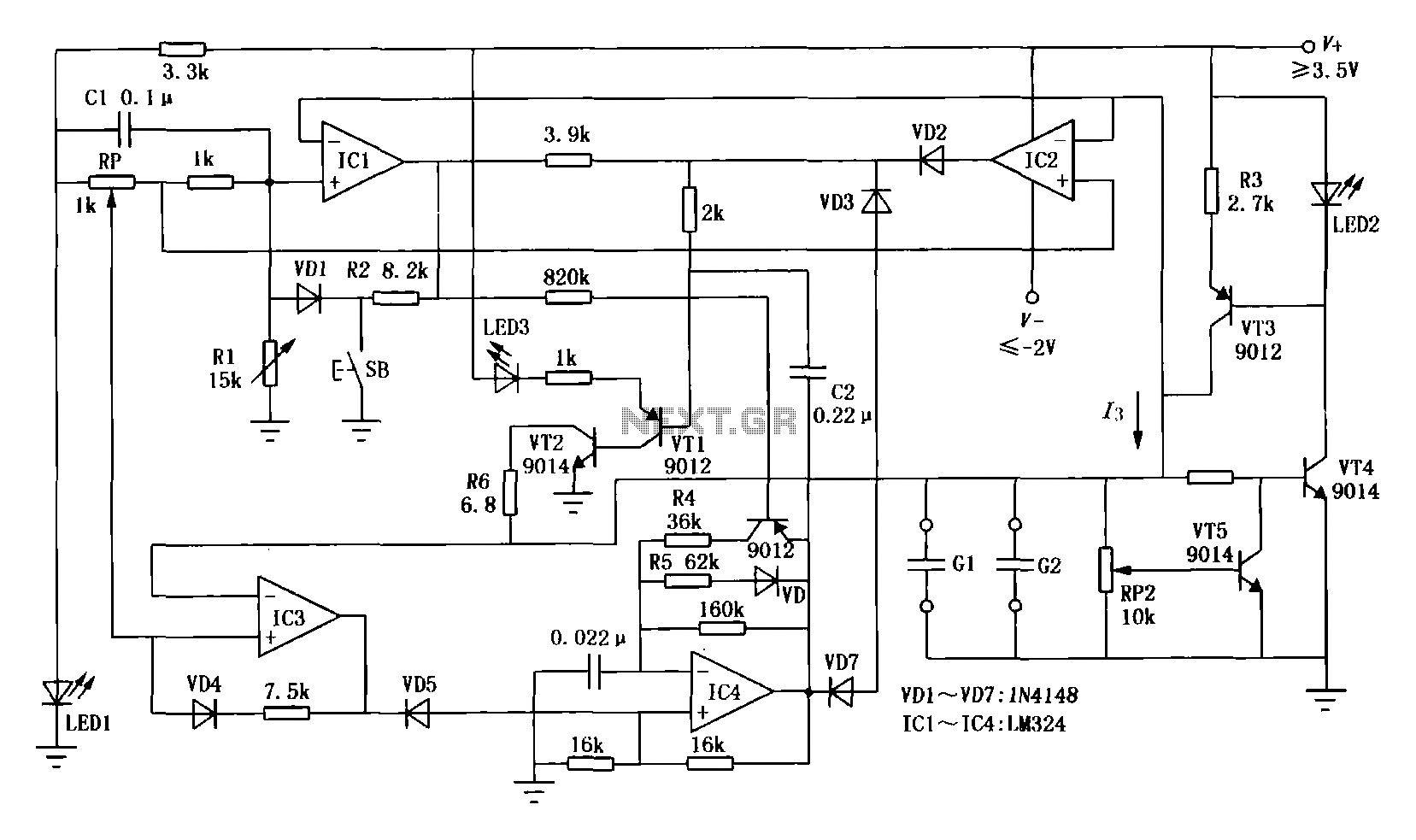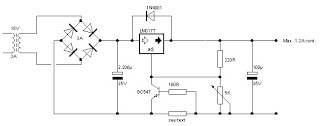
Self-Powered Fast Battery Tester Schematic
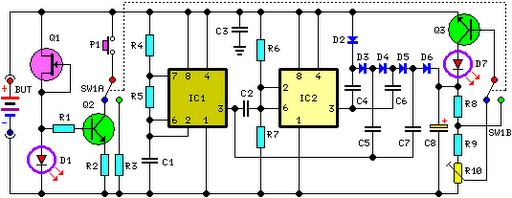
FET Q1 functions as a constant current generator, providing biasing for LED D1 and the base of Q2. This configuration ensures that D1 emits light at a consistent intensity, regardless of the battery voltage, which ranges from 3 to 15V. When switch P1 is closed, Q2 applies a constant current load of approximately 120mA to the battery. IC1 serves as a square wave generator oscillating at around 3KHz, while IC2 operates as an inverter. Together with IC1, but in anti-phase, they drive diodes D2-D6 and capacitors C4-C7, facilitating voltage multiplication. Capacitor C8 is charged by the elevated voltage, and resistors R8-R10 create a voltage divider to bias the base of Q3. When P1 is open, a minimal load is applied to the battery under test, keeping Q3's base biased to ensure that LED D7 remains off. When P1 is closed, a 120mA load is applied to the battery under test. If the battery is not fully charged, its output voltage begins to drop. When this voltage decreases to 0.6V below the nominal battery voltage, Q3's emitter becomes more negative than its base, causing the transistor to be hard biased and LED D7 to illuminate. This condition lasts for a few seconds, which corresponds to the time required for C8 to discharge to the new voltage level, proportional to the voltage of the loaded battery. If the battery under test maintains its output voltage under a 120mA load, LED D7 remains off. For testing 1.5V batteries, the circuit comprising Q1, Q2, D1, and resistors R1 and R2 is ineffective at this voltage level. Therefore, a 150mA load current is applied to the battery under test using a 10 Ohm resistor R3 when switch SW1A is activated. The biasing of Q3 is also modified through switch SW1B.
FET Q1 plays a critical role in regulating the current supplied to LED D1 and Q2's base. The constant current generator design ensures that the LED maintains a steady brightness, which is essential for visual feedback during testing. The operational range of the circuit, accommodating battery voltages from 3V to 15V, allows for versatility in assessing various battery types.
IC1's function as a square wave generator is fundamental to the circuit's operation. The oscillation at approximately 3KHz enables the subsequent voltage multiplication process. IC2's role as an inverter complements IC1, allowing for the effective driving of diodes D2-D6 and capacitors C4-C7 in a manner that enhances voltage levels through a capacitive charge and discharge cycle.
The voltage divider formed by resistors R8-R10 is crucial for setting the biasing conditions for Q3. When P1 is not engaged, the circuit minimizes load on the battery under test, ensuring accurate voltage readings without significant drain. The transition of Q3 to an on state, indicated by the illumination of LED D7, serves as a visual cue that the battery's voltage has fallen below acceptable levels, prompting further action or testing.
In scenarios involving 1.5V batteries, the circuit adapts by applying a higher load current, thus ensuring accurate testing even at lower voltage levels. The inclusion of switches SW1A and SW1B provides user control over the load conditions and biasing of Q3, enhancing the circuit's functionality and adaptability for different battery types. Overall, this circuit design presents a robust solution for battery testing, combining constant current generation, voltage multiplication, and conditional loading to deliver reliable performance across a range of battery voltages.FET Q1 provides a constant current generator biasing LED D1 and Q2 Base. In this manner D1 illuminates at a constant intensity, independent of battery voltage from 3 to 15V and Q2 (when P1 is closed) applies a constant current load of about 120mA to the battery. IC1 is a square wave generator oscillating at about 3KHz. IC2 acts as an inverter and drives, together with IC1 but in anti-phase, Diodes D2-D6 and Capacitors C4-C7, obtaining a voltage multiplication. C8 is charged by this raised voltage and R8-R10 form a voltage divider biasing the Base of Q3. When P1 is open, a very light load is applied to the battery under test and Q3 Base is biased in order to maintain LED D7 in the off state.
Closing P1, a 120mA load is applied to the battery under test. If the battery is not fully charged, its output voltage starts reducing: when this voltage fall 0. 6V below the battery nominal voltage, Q3 Emitter becomes more negative than the Base, the transistor is hard biased and D7 illuminates. Obviously, this state of affairs will last a few seconds: the time spent by C8 to reduce its initial voltage to the new one, proportional to the voltage of the loaded battery.
If the battery under test is in a good charging state, its output voltage will not fall under a 120mA loading current, so LED D7 will stay off. When testing 1. 5V batteries, the circuit formed by Q1, Q2, D1, and R1 & R2 does not work well at this supply voltage, so a 150mA load current is applied to the BUT by means of the 10 Ohm resistor R3 after switching SW1A.
Q3 bias is also changed via SW1B. 🔗 External reference
FET Q1 plays a critical role in regulating the current supplied to LED D1 and Q2's base. The constant current generator design ensures that the LED maintains a steady brightness, which is essential for visual feedback during testing. The operational range of the circuit, accommodating battery voltages from 3V to 15V, allows for versatility in assessing various battery types.
IC1's function as a square wave generator is fundamental to the circuit's operation. The oscillation at approximately 3KHz enables the subsequent voltage multiplication process. IC2's role as an inverter complements IC1, allowing for the effective driving of diodes D2-D6 and capacitors C4-C7 in a manner that enhances voltage levels through a capacitive charge and discharge cycle.
The voltage divider formed by resistors R8-R10 is crucial for setting the biasing conditions for Q3. When P1 is not engaged, the circuit minimizes load on the battery under test, ensuring accurate voltage readings without significant drain. The transition of Q3 to an on state, indicated by the illumination of LED D7, serves as a visual cue that the battery's voltage has fallen below acceptable levels, prompting further action or testing.
In scenarios involving 1.5V batteries, the circuit adapts by applying a higher load current, thus ensuring accurate testing even at lower voltage levels. The inclusion of switches SW1A and SW1B provides user control over the load conditions and biasing of Q3, enhancing the circuit's functionality and adaptability for different battery types. Overall, this circuit design presents a robust solution for battery testing, combining constant current generation, voltage multiplication, and conditional loading to deliver reliable performance across a range of battery voltages.FET Q1 provides a constant current generator biasing LED D1 and Q2 Base. In this manner D1 illuminates at a constant intensity, independent of battery voltage from 3 to 15V and Q2 (when P1 is closed) applies a constant current load of about 120mA to the battery. IC1 is a square wave generator oscillating at about 3KHz. IC2 acts as an inverter and drives, together with IC1 but in anti-phase, Diodes D2-D6 and Capacitors C4-C7, obtaining a voltage multiplication. C8 is charged by this raised voltage and R8-R10 form a voltage divider biasing the Base of Q3. When P1 is open, a very light load is applied to the battery under test and Q3 Base is biased in order to maintain LED D7 in the off state.
Closing P1, a 120mA load is applied to the battery under test. If the battery is not fully charged, its output voltage starts reducing: when this voltage fall 0. 6V below the battery nominal voltage, Q3 Emitter becomes more negative than the Base, the transistor is hard biased and D7 illuminates. Obviously, this state of affairs will last a few seconds: the time spent by C8 to reduce its initial voltage to the new one, proportional to the voltage of the loaded battery.
If the battery under test is in a good charging state, its output voltage will not fall under a 120mA loading current, so LED D7 will stay off. When testing 1. 5V batteries, the circuit formed by Q1, Q2, D1, and R1 & R2 does not work well at this supply voltage, so a 150mA load current is applied to the BUT by means of the 10 Ohm resistor R3 after switching SW1A.
Q3 bias is also changed via SW1B. 🔗 External reference
Warning: include(partials/cookie-banner.php): Failed to open stream: Permission denied in /var/www/html/nextgr/view-circuit.php on line 713
Warning: include(): Failed opening 'partials/cookie-banner.php' for inclusion (include_path='.:/usr/share/php') in /var/www/html/nextgr/view-circuit.php on line 713
